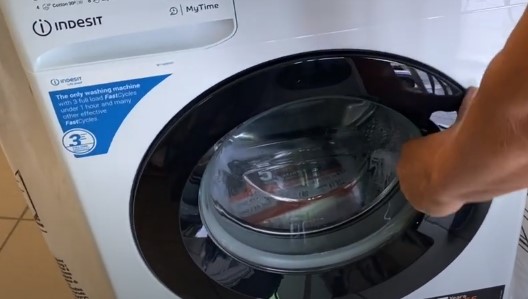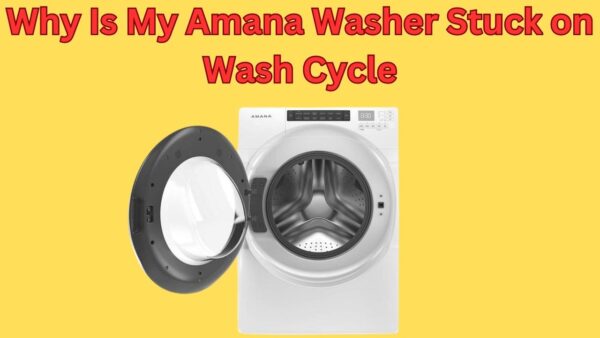A washer slowly filling with water when not in use is a surprisingly common problem that many homeowners encounter. Did you know that even a small leak can waste up to 10,000 gallons of water per year?
This issue not only spikes water bills but can also lead to mold, rust, and other costly damage if left unchecked. With the right knowledge, you can troubleshoot and resolve these issues without unnecessary stress.
This blog will guide you through understanding why your washer might slowly fill with water when not in use, how to stop water dripping into your washing machine, and ways to prevent it in the future.
Plus, we’ll show you how to hire a reliable technician if you need professional help. Let’s get started!
How to Stop Water Dripping into Washing Machine
Water dripping into your washing machine can be a hassle, but fixing it doesn’t have to be complicated. First, check the water inlet valve as this is often the main cause of leaks—it might be stuck or worn out.
Cleaning or replacing the valve could stop the dripping if it’s the issue. Another possibility is a clogged or damaged hose; inspect it for blockages or cracks and clean or replace it as needed. If the problem persists, it could be a faulty pressure switch, timer, or control board, which requires proper testing.
Handling electrical components without the right skills can be risky, so the best way to fix it is to hire a technician for safety purposes.
Professionals will not only identify the root cause but also ensure the repair is done correctly, saving you time and preventing further damage.
Why is my washing machine filling up so slowly?
A washing machine filling up slowly can be incredibly frustrating and might make you wonder what’s wrong. One common cause is a clogged water inlet filter, which blocks the flow of water into the machine.
Over time, dirt, sediment, or mineral buildup can create this issue. Another possibility is low water pressure in your home, which can delay the machine’s filling cycle.
A malfunctioning water inlet valve could also be to blame, as it might not open fully to allow water through. Check for kinks or blockages in the fill hoses, as these can restrict water flow.
Addressing these issues quickly ensures your machine runs smoothly and saves you both time and potential repair bills.
10 Solution of Washer Slowly Fills With Water When Not in Use

1. Faulty Water Supply Valve
Cause:
A malfunctioning water supply valve is often the culprit. Over time, the valve may wear out, allowing water to seep into the washer drum slowly. It doesn’t fully shut when the washer is off, leading to this problem.
Mineral deposits or general wear and tear are frequent causes of the valve’s failure. Even when the washer isn’t in use, water continues to leak through the faulty valve. This can lead to increased water bills and even mold growth.
Solution:
Replace the water supply valve immediately. First, turn off the water supply to the washer. A plumber can replace the valve, or you can tackle it yourself with the right tools.
While replacing the valve, clean any mineral buildup to prevent future leaks. Regular maintenance of the washer’s components can help avoid this problem. Always check the new valve’s function after installation to make sure it’s shutting correctly.
2. Clogged Water Fill Hose
Cause:
The water fill hose might be clogged with debris. Over time, sediments or mineral deposits can block the hose, causing water to back up and slowly enter the washer drum.
Even when the washer isn’t running, the blockage allows water to escape into your washer. A clogged hose can also stress the water supply system. Left unresolved, this could worsen the problem and increase repair costs.
Solution:
Disconnect the water fill hose from the washer and inspect it for clogs. Flush out the debris with clean water until the hose runs clear. If the hose is damaged or badly clogged, replacing it is the smartest option.
Before reconnecting, check the entire water supply system for leaks or blockages. Use a water filter on your supply line to minimize sediment buildup. Routine cleaning keeps this issue at bay.
3. Defective Pressure Switch
Cause:
The pressure switch monitors water levels in the washer. A defective switch may not signal the washer to stop filling with water. When this part malfunctions, it confuses the washer, allowing water to trickle in even when turned off. Electrical faults or wear can cause the problem. Over time, this minor leak can lead to serious water damage.
Solution:
Test the pressure switch for proper function using a multimeter. If it’s defective, replacing it is your best bet. Consult your washer manual to ensure you purchase the correct part for your model.
Once replaced, test the washer to confirm it’s resolving the slow fill issue. Regularly checking components like the pressure switch adds years to the life of your appliance. Catching a faulty switch early can save both time and money.
4. Leaky Water Inlet Valve
Cause:
The water inlet valve controls the flow of water into the washer drum. A leaky valve allows small amounts of water to drip into the machine when it’s off. Age, wear, or mineral buildup may cause the valve to malfunction. This is one of the most common reasons a washer slowly fills with water when not in use. A worn gasket could also contribute to the leak.
Solution:
Inspect the water inlet valve for leaks and replace it if necessary. Shut off the water supply before removing the valve for inspection. Clean out any debris and check the valve gasket for wear. If the valve is damaged, switch it out with a new one. After installation, test the washer for any continued leaking. Checking your inlet valve yearly helps catch these issues early.
5. Worn Out Drain Valve
Cause:
The drain valve removes water after each cycle. When it wears out, it can cause backflow, leading to the washer slowly filling with water when not in use. This could happen due to a damaged seal or improper closure.
The valve might also become stuck due to debris or hard water deposits. A worn-out drain valve can cause both functionality problems and water waste.
Solution:
Replace the defective drain valve promptly. Disassemble the washer to access the valve and check for visible damage. Clean it to remove buildup and see if the problem resolves. If cleaning doesn’t work, it’s time for a replacement. Hire a professional if you’re unsure how to handle this. Lastly, avoid using harsh detergents that can speed up valve wear.
6. Incorrect Water Pressure
Cause:
Low water pressure can cause the washer slowly to fill with water when not in use. It happens when the water doesn’t flow at a steady rate into the machine. This issue can also strain other parts of your washer. Over time, irregular water pressure can damage components like the inlet valve or pressure switch. A water meter error might also be behind inconsistent pressure.
Solution:
Check your home’s water pressure using a pressure gauge. If it’s too low or too high, adjust the regulator on your water supply line. Contact a plumber if you’re unsure how to fix this. Cleaning your water supply lines can also improve pressure. For long-term stability, consider installing a water pressure monitoring device. Avoid overloading your washer with heavy cycles during water pressure issues.
7. Broken Timer or Control Board
Cause:
Washers rely on timers or control boards to dictate water intake cycles. A broken timer may keep sending signals to fill the drum even when the machine is off. Electrical issues or short circuits are often the root cause. Over time, this can lead to increased wear on other components. A faulty timer might also disrupt other washer functions.
Solution:
Replace the timer or control board to restore proper function. Hire a professional to diagnose the issue using an electrical tester. If you’re experienced, you can replace the control board carefully following the user manual. Test the washer after replacing electronic components to ensure success. To avoid electrical damage, use surge protectors for your appliances. Regular servicing will keep your timer or control board working smoothly.
8. Faulty Float Assembly
Cause:
The float assembly monitors water levels inside the washer. A broken float might fail to stop water from entering the drum. This malfunction can cause a washer to slowly fill with water when not in use. It’s a common issue in older machines. Over time, floating mechanisms may get stuck or lose accuracy.
Solution:
Inspect the float assembly for damage or debris. Cleaning it thoroughly might solve the problem. If the float is broken, find a replacement specific to your washer model. Install the new float and test your washer to confirm it’s working properly. Keep the area around the float clean to prevent future problems. Often, simple maintenance makes a big difference.
9. Blocked Drain Hose
Cause:
A clogged drain hose might cause water to flow back into the washer. Debris or buildup in the hose prevents water from properly draining out. This means leftover water can slowly seep back into the drum over time. A blocked hose can also strain the washer’s pump and other parts. Over time, this issue can lead to serious leakage.
Solution:
Detach the drain hose and clean it thoroughly. Remove any visible clogs and flush the hose with water. Replace the hose if it’s damaged or worn out. To prevent future blockages, use clog-preventing detergents and avoid overloading your washer. Regularly inspecting and cleaning the drain hose is key to preventing similar issues. This will help your washer stay in top shape.
10. Improper Washer Installation
Cause:
Bad installation can cause a washer to slowly fill with water when not in use. For example, improper alignment of hoses or valves might create leakage. If the washer isn’t level, water may not drain out properly after cycles. Incorrect installation can also damage the machine over time. Misaligned components are a frequent source of slow fills.
Solution:
Double-check your washer installation. Align hoses and valves correctly and make sure the washer is sitting level. Follow the manufacturer’s manual for proper setup. If you’re unsure, hire a professional to install it for you. Re-check all connections to prevent leaks. Proper installation saves you from unexpected problems and costly repairs.
How to Prevent Washer Slowly Fills With Water When Not in Use?
Dealing with a washer slowly filling with water when not in use can be a headache. If you’re tired of water trickling into your washing machine or noticing mysterious puddles, prevention is key.
These five tips will help you keep your washer running smoothly and avoid bigger problems. Let’s break it down in a way that’s simple and easy to follow.
1. Check and Replace Water Supply Valves Regularly
A worn-out or faulty water supply valve is often why your washer slowly fills with water when not in use. Over time, these valves may not seal properly, causing water to drip into the drum even when the washer is off.
Inspect them for any wear, leaks, or mineral buildup that could block proper closure. If you notice your washer keeps filling with water even when the machine is off, it’s time to replace the valve.
Regular maintenance of these parts will also help prevent water dripping inside the tub of your washing machine.
2. Keep Hoses Clean and Properly Attached
Blocked or improperly installed hoses can be a reason for water dripping inside your washer. A clogged hose can lead to incomplete water drainage, which may explain why your washing machine keeps filling with water when turned off.
Disconnect the water fill and drain hoses and flush them clean to remove debris or buildup. Make sure the hoses are tightly secured and in good condition to avoid leaks causing the washer to fill up with water unnecessarily.
Preventing hose blockages ensures your washer won’t stop filling with water during regular use.
3. Inspect and Maintain the Water Inlet Valve
The water inlet valve controls the flow of water into your washer, and a leak here can cause your washer filling with water when off. Mineral deposits or wear can lead to small drips over time, especially with front-load washers where water pressure fluctuates.
To prevent the issue, clean this valve with a soft brush and check for any worn parts. If the valve is causing your washing machine filling with water when off, replacing it is often the best solution.
Ensuring it stays clean and functional will keep you from wondering why your washer isn’t filling up with water properly.
4. Replace Defective Float Assembly or Pressure Switch
If the float assembly or pressure switch is faulty, it might not stop the washer from letting water through, leading to issues like water keeps running in the washer.
Regularly inspect the float for debris or misalignment and test the pressure switch for proper operation. A broken float can also cause your washing machine filling with water slowly or dripping inside.
If your machine won’t stop filling with water even when off, replacing these parts is essential. This small replacement can prevent major problems like your washer filling with water unexpectedly.
5. Regulate Water Pressure and Install Protective Filters
Unstable water pressure can harm your washer, as low pressure forces water to trickle into the machine incorrectly.
If you notice your washing machine dripping water inside or filling too slowly, a water pressure monitor or regulator can help.
High water pressure can also wear out valves, so keeping it steady extends the life of your appliance.
Install a sediment filter to reduce mineral and debris buildup, which may explain why your GE washer keeps dripping water into the tub. Proper pressure and filtration ensure your washing machine stops filling with water the way it’s meant to.
Washing machine dripping water insideInstall a sediment filter to reduce mineral and debris buildup, which may explain why your GE washer keeps dripping water into the tub. Proper pressure and filtration ensure your washing machine stops filling with water the way it’s meant to.
Where to Hire a Technician for a Washer Slowly Fills With Water When Not in Use?
A washer slowly filling with water when not in use can be a frustrating problem.
Whether it’s water trickling into the washing machine or any amana washer sensing fill light blinkingg up with water even when off, fixing it oftenwasher slowly fills with water when not in use requires the expertise of a qualified technician. Knowing where to find a professional is just as important as solving the issue itself.
To make things easier, here’s a list of five reliable places to hire a technician to fix your washer’s filling issue. Each option comes with its own benefits, so you can choose the one that works best for you.
1. Appliance Repair Companies
Most appliance repair companies specialize in fixing problems like a washer that keeps filling with water. These companies hire experienced technicians who can diagnose and repair issues like water dripping into the washing machine.
They often provide on-site service, so you don’t need to move your washer.
Simply search for local repair companies online or check reviews to find the best-rated option nearby. By choosing a reputable company, you can ensure that your washing machine filling with water when turned off is handled effectively. Additionally, many of these companies offer guarantees for their work, giving you extra peace of mind.
2. Manufacturer’s Service Centers
If you own a brand-name machine, reaching out to the manufacturer’s service center is a great option. They have technicians specifically trained to handle issues like why your washer fills with water when off.
Call the customer service line or check their website to book a repair appointment. This approach is ideal for addressing unique problems like why your washer keeps filling with water.
They can also provide advice if your washer dripping water inside the tub requires a part replacement. While this option may cost more, you’ll get service backed by your washer’s brand reputation.
3. Online Marketplaces
Websites like TaskRabbit, Thumbtack, or Angie’s List make it easy to hire a technician for a washing machine filling with water. On these platforms, you can scroll through profiles, read reviews, and hire someone experienced.
Many freelance technicians specialize in diagnosing tricky problems like why your washing machine won’t stop filling with water.
Once you find someone suitable, they’ll come to your location and investigate the problem. This is especially helpful if your front load washer filling with water when off is causing stress. Best of all, pricing is usually competitive, and you’ll have clear communication through the marketplace.
4. Local Hardware Stores
Some local hardware stores work with certified repair technicians who can resolve issues like water dripping into your washing machine. They usually have partnerships with nearby repair professionals and can guide you to someone experienced.
Hardware stores are particularly helpful if your washing machine keeps filling with water when off due to faulty parts.
The technician can fix the issues and even recommend the right parts if replacements are needed. Having access to both repairs and equipment in one place makes this an efficient choice for addressing washing machine problems.
5. Home Warranty Providers
If you have a home warranty plan, your provider likely offers repair services for appliances that develop issues like why your washer fills with water when not in use. Contact your warranty company to file a claim, and they’ll arrange for a professional technician to visit.
This can save you money compared to booking a repair directly, especially if the washer filling with water when off needs expensive parts replaced.
Warranty-provided repairs are often reliable because they vet their technicians thoroughly. This option is especially good for complicated cases like washing machine keeps filling with water even when turned off.
Conclusion
A washer that slowly fills with water when not in use is likely symptomatic of a faulty water valve or a problem in the control panel.
This condition, while seemingly minor, should not be ignored as it can lead to larger issues such as overflow, water damage, and increased utility bills.
It’s recommended that you promptly address this issue, either by attempting DIY fixes like cleaning the inlet screens or by calling a professional to replace the faulty parts or resolve complex issues.
By doing so, you can ensure the longevity of your washer and its efficient performance.


